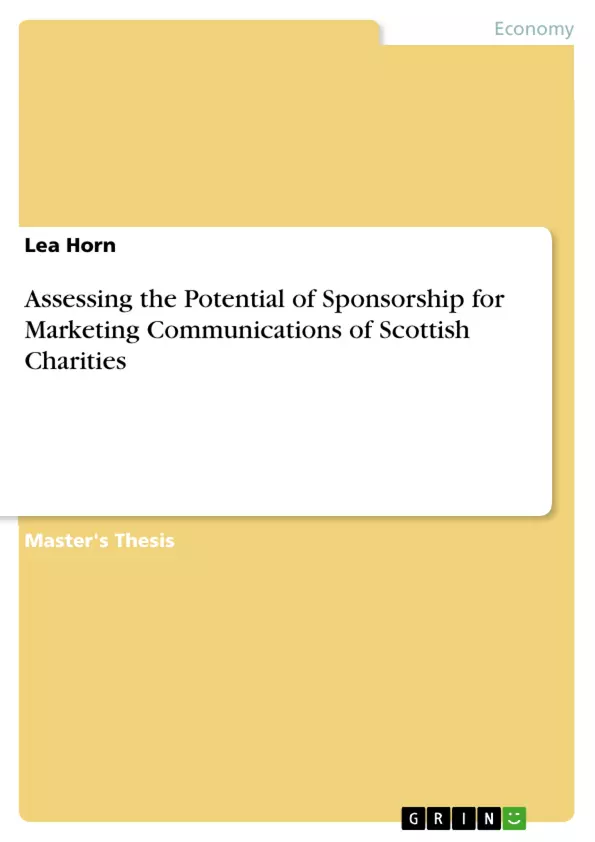Recent trends in the charity sector predict a challenging future in terms of procuring funding, as the Scottish Government is likely to decrease funds allocated to the third sector. In this context, this study aims to critically evaluate the potential of sponsorship as a marketing communications method for Scottish charities with focus on charities as the sponsoring entity.
The author considers this assessment important, as it possibly holds the potential to generate sustainable government-independent funding through increased brand and cause awareness. The study is supported by a qualitative mono-method inductive research approach consisting of seven individual face-to-face interviews with a panel of experts from the corporate and charity marketing industries. Comparing marketing communications theory, sponsorship theory in particular as well as third sector theory with the research findings, this research project arrives at outlining possibilities for the development of starting points to develop fund-procuring methods with the means of sponsorship or adapted forms of it. One can record the following assumptions in regard to the feasibility of an implementation of sponsorship into charity marketing communications: Sponsorship provides significant benefits in terms of brand enhancement and identification, which would allow for a more targeted communication of the cause. Sponsorship can be deemed effective; yet, there is no predictability in measurement, which decreases its full applicability. Despite its favourable benefits, sponsorship is not viewed as viable for a use in the charity context due to a moral dilemma in justifying its cost. However, alterations or particular sections of sponsorship might be imaginable.
Nonetheless, the study is underpinned by limitations like the small sample size and restricted locational aspects surrounding the sampling, which, however, offer great potential for future research in this field.
Inhaltsverzeichnis (Table of Contents)
- Introduction
- Purpose and Background of the Study
- Aim and Objectives
- Overview of the Research Approach and Methodology
- Industry Context of the Third Sector
- Introduction
- Third Sector in Scotland
- Challenges of the Sector
- Conclusion
- Literature Review
- Introduction
- Common Practice in Marketing Communications
- Sponsorship as a Form of Marketing Communications
- Common Practice in Charity Communications
- Message Framing
- Strategic Branding
- Giving Mechanisms
- Conclusion
- Research Design and Methods
- Introduction
- Research Philosophy
- Research Approach
- Research Strategy
- Data Collection Methods
- Conclusion
- Research Results
- Introduction
- Development of Key Themes
- Sponsorship and Brand Enhancement
- Sponsorship and Marketing Communications
- Conclusion
- Discussion
- Introduction
- Final Assumptions
- Practical Implications for Scottish Charities
- Limitations and Future Research
- Conclusion
Zielsetzung und Themenschwerpunkte (Objectives and Key Themes)
The study aims to critically evaluate the potential of sponsorship as a marketing communications method for Scottish charities. The author investigates the feasibility of using sponsorship as a funding mechanism, focusing on charities as the sponsoring entity. The research explores whether sponsorship can generate sustainable government-independent funding through increased brand and cause awareness.
- The potential of sponsorship as a marketing communications method for Scottish charities
- The feasibility of sponsorship as a funding mechanism for charities
- The role of sponsorship in generating sustainable government-independent funding
- The benefits and challenges of sponsorship for charity marketing
- The development of starting points for implementing sponsorship in charity marketing communications
Zusammenfassung der Kapitel (Chapter Summaries)
- Introduction: This chapter introduces the study's purpose, background, aims, objectives, and research approach.
- Industry Context of the Third Sector: This chapter provides an overview of the third sector in Scotland, highlighting its challenges, particularly in securing funding.
- Literature Review: This chapter explores existing literature on marketing communications, sponsorship, and charity communications, establishing a theoretical foundation for the study.
- Research Design and Methods: This chapter outlines the research design and methodology used in the study, including the research philosophy, approach, strategy, and data collection methods.
- Research Results: This chapter presents the key findings of the study, including the development of themes related to sponsorship and brand enhancement, and sponsorship and marketing communications.
- Discussion: This chapter analyzes the research findings, discusses final assumptions, and presents practical implications for Scottish charities. It also addresses limitations and suggests future research directions.
Schlüsselwörter (Keywords)
The study focuses on the potential of sponsorship as a marketing communications method for Scottish charities, particularly in the context of a challenging funding environment. Key terms include sponsorship, marketing communications, third sector, Scottish charities, brand enhancement, cause awareness, funding, and sustainable funding.
- Citation du texte
- Lea Horn (Auteur), 2017, Assessing the Potential of Sponsorship for Marketing Communications of Scottish Charities, Munich, GRIN Verlag, https://www.grin.com/document/385814



